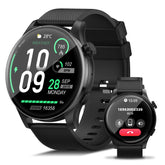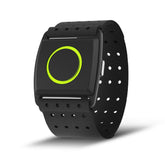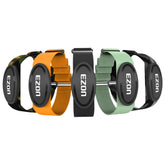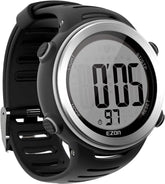Optimal Heart Rates for Different Workouts: A Comprehensive Guide
Understanding your heart rate during exercise isn’t just about hitting numbers—it’s about optimizing performance, preventing injury, and avoiding life-threatening risks. Whether you’re a HIIT enthusiast or a long-distance runner, this guide breaks down the science of heart rate zones, monitoring techniques, and how a heart rate monitor watch like the EZON Watch can become your ultimate training partner.
1. Why Heart Rate Monitoring Matters
Your heart rate is a direct window into your body’s response to exercise. Studies show that exercising at the wrong intensity increases risks like arrhythmias or sudden cardiac events, especially in those with undiagnosed conditions like hypertrophic cardiomyopathy. Here’s what you need to know:
-
Safe thresholds: For most adults, the minimum effective aerobic intensity is 45% of maximum heart rate (HRmax), while HIIT should stay within 70-95% HRmax during high-intensity intervals.
-
Sudden cardiac risk: Over 80% of exercise-related fatalities involve undetected heart issues. A heart rate monitor watch helps flag dangerous spikes (e.g., >90% HRmax without gradual adaptation).
2. Heart Rate Zones for Different Workouts
A. Steady-State Cardio (50-70% HRmax)
-
Best for: Fat burning, endurance building
-
Example: A 35-year-old runner’s target HR = (220-35) × 60-70% = 111-130 bpm
-
Tool tip: The EZON Watch’s dual-sensor tech reduces optical errors during low-intensity sessions.
B. High-Intensity Interval Training (HIIT) (80-95% HRmax)
-
Optimal protocol: 4-minute intervals at 80% HRmax, followed by 4-minute recovery at 50% HRmax (proven safe even for heart failure patients【3】).
-
Avoid pitfalls: Chest straps like Polar H10 outperform wrist-based monitors for HIIT accuracy, but the best sports watch for workouts (e.g., EZON Watch Pro) combines ECG-grade sensors with dynamic calibration.
C. Recovery Sessions (<60% HRmax)
-
Science-backed: Keeping HR below 60% HRmax boosts parasympathetic activity, accelerating muscle repair.
-
Watch feature: The EZON Watch’s “Recovery Score” analyzes HR variability (HRV) to recommend rest days.
D. Endurance Training (70-80% HRmax)
-
Marathon prep: Maintain 75% HRmax for glycogen efficiency. Use the Karvonen formula for precision:
Target HR = (HRmax - resting HR) × intensity% + resting HR
Example: Resting HR=60, HRmax=185 → Target = (125 × 0.7) + 60 = 148 bpm
3. Choosing the Best Heart Rate Monitor Watch
Not all wearables are created equal. Here’s how to pick the best sports watch for workouts:
| Feature | Why It Matters | Top Pick |
|---|---|---|
| Sensor Accuracy | Chest straps (Polar H10) error: ±2 bpm; Wrist optical sensors: ±5-10 bpm | EZON Watch V3 (medical-grade PPG + ECG) |
| Battery Life | 20+ hours GPS mode for ultramarathons | Garmin Enduro 2 (150h) |
| Zone Alerts | Customizable vibration/audio for HR limits | EZON Watch Pro (5-zone alerts) |
| App Integration | Sync with Apple Health/Strava | Fitbit Charge 6 |
Why EZON Watch Stands Out:
-
Multi-mode monitoring: Seamlessly switches between optical, ECG, and chest strap pairing.
-
AI-powered insights: Detects abnormal HR spikes (e.g., >95% HRmax) and suggests immediate cooldowns.
-
Athlete-specific algorithms: Adapts HR zones for runners, cyclists, and swimmers.
4. How to Measure Heart Rate Accurately
-
Chest straps: Gold standard for HIIT (Polar H10: 99% lab accuracy).
-
Wrist-based optical: Convenient but less reliable during sprints. The EZON Watch’s 8-LED array minimizes motion artifacts.
-
Manual checks: Count pulse for 15 seconds × 4 (error margin: ±5 bpm).
5. Future Trends in Heart Rate Tech
-
AI-driven predictions: Watches forecasting HR zones based on weather, fatigue, and hydration (beta in EZON Watch 2025).
-
Non-invasive glucose + HR fusion: Early warnings for hypoglycemia-induced HR spikes.
-
LEO satellite HR monitoring: Emergency HR alerts in remote areas via low-orbit networks.
6. Safety First: Red Flags to Watch
-
Danger zone: Sustained HR >90% HRmax without gradual adaptation.
-
Resting HR spikes: A 10+ bpm increase overnight may signal overtraining or illness (track via EZON Watch’s Sleep Mode).
-
Post-workout drop delay: Healthy HR should drop 20+ bpm within 1 minute post-exercise.
Final Word
A heart rate monitor watch isn’t just a gadget—it’s your safeguard against overexertion and a coach for precision training. The EZON Watch leads the pack as the best sports watch for workouts, merging clinical accuracy with athlete-centric features. Whether you’re chasing a marathon PB or a metabolic boost, let your heart rate guide you to smarter, safer gains.









